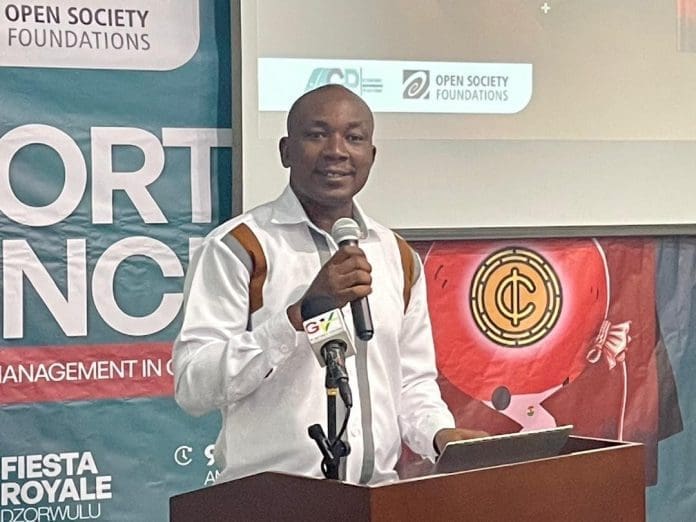The Bank of Ghana has cut its monetary policy rate from 25% to 21.5% in September, with the 91-day Treasury Bill rate falling to 10.3% and average lending rates dropping to 24.15% by August. On paper, these developments suggest businesses and individuals can borrow at lower costs to expand and drive economic activity.
But what if there’s actually no money available to borrow? That’s the paradox Prof. Godfred Bokpin of the University of Ghana Business School is highlighting, arguing that aggressive central bank interventions to defend the exchange rate are absorbing liquidity that could have been available for businesses to borrow at low cost.
The central bank has managed to bring the cedi-dollar rate down significantly, with the currency appreciating more than 40% earlier this year, though it’s experienced volatility, swinging between levels before settling around current rates. These interventions are meant to inspire confidence and demonstrate policy effectiveness.
However, as Prof. Bokpin warns, the billions of cedis used to defend the currency through Bank of Ghana interventions have come at the expense of credit availability. “That credit, which could have been available for businesses to borrow at low cost, expand, and create jobs, is no longer available,” he explained in a recent interview.
The economist describes this as achieving exchange rate gains “at a great cost to private sector competitiveness.” He’s pointed out that while the Bank of Ghana’s interventions have helped stabilize the cedi, they’ve drained liquidity from the financial system, leaving banks cautious and credit scarce.
Speaking at Prudential Bank’s Cedi Appreciation Seminar, Prof. Bokpin said “the kind of interest rate we have can only fund imports and not production or manufacturing”, highlighting how the current environment remains misaligned with growth objectives despite lower policy rates.
He’s drawn comparisons with Kenya, where businesses can borrow at around 10%, contrasting sharply with Ghana’s environment where lending rates remain elevated despite headline improvements. “If our rates are not aligned, we are denying private capital the opportunity to expand and employ,” he noted.
Prof. Bokpin argues that policymakers have become overly fixated on the exchange rate rather than real growth indicators like job creation, business expansion, and productive capacity. He’s cautioned that “32 million people are obsessed with a low exchange rate,” even as this obsession drives destructive activities like illegal mining.
The economist emphasizes that true economic strength should be measured by tangible outcomes, not symbolic victories. Businesses and investors, especially those in the diaspora, care about stability and predictability, not whether the exchange rate is artificially maintained at a particular level.
Prof. Bokpin has also noted that when exchange rate adjustments are too sharp, “projects are put on hold,” as businesses struggle to plan effectively. Gradual, predictable movements would allow firms to make better long-term decisions.
The current situation creates a troubling disconnect. Policy rates signal that borrowing should be getting cheaper and credit should be flowing to productive sectors. The central bank has projected headline inflation will fall within its medium-term target band of 8%, plus or minus 2 percentage points, by year-end, theoretically creating space for even more easing.
GDP grew 6.3% in the second quarter of 2025, with non-oil output expanding 7.8%, led by services and agriculture. External balances have strengthened considerably, with gross international reserves standing at $10.7 billion at end-August, equivalent to 4.5 months of import cover.
Yet despite these improvements, the transmission mechanism from policy rates to actual credit availability appears broken. Banks remain conservative, businesses report difficulty accessing affordable financing, and the productive sectors that government says it wants to support struggle to secure the capital they need.
Prof. Bokpin has credited the current administration for fiscal discipline and economic management, noting clear signs of direction and leadership. He’s acknowledged that inflation fell sharply from 23.8% in December 2024 to 13.7% by June 2025, faster than previous disinflation cycles.
However, he’s urged policy managers to focus on measures that support sustainable growth and ensure adequate credit availability, rather than chasing symbolic victories through exchange rate manipulation. The concern is that short-term optics are undermining long-term development and private sector confidence.
Bank of Ghana Governor Dr. Johnson Asiama has called on banks to “stimulate credit to productive areas of the economy” including agriculture, manufacturing, infrastructure and SMEs, while maintaining prudent risk management. The question is whether banks can actually do this when liquidity is being absorbed elsewhere in the system.
The paradox Ghana faces is this: all the technical indicators suggest the economy is stabilizing and credit should be flowing. Interest rates are falling, inflation is moderating, the currency has strengthened, and fiscal discipline has improved. But if the mechanisms used to achieve exchange rate stability are simultaneously draining the liquidity needed for private sector lending, then the headline numbers mask a more complex reality.
Prof. Bokpin’s fundamental message is that economic policy should prioritize real outcomes over optics. How many jobs are being created? How many businesses are expanding? How productive is the economy becoming? If policymakers lose sight of these fundamentals in pursuit of exchange rate targets, the technical achievements may prove hollow.
The billions of cedis locked in currency defense could alternatively have funded manufacturing expansion, agricultural modernization, or small business growth. That’s the opportunity cost the economist is highlighting, even as he acknowledges the government’s overall economic management efforts.
For businesses watching from the sidelines, the message is sobering: rates may look cheaper on paper, but accessing actual credit remains challenging. The system appears to be caught between competing objectives, stabilizing the currency versus providing liquidity for growth, and for now, the former seems to be winning.
Source: newsghana.com.gh











